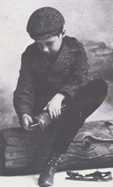 Family Folklore
Family Folklore
How to Collect Your Own Family Folklore
Presentation
Family tape recordings and photographs that are worth collecting are also worth preserving. Although professional archival techniques are rather elaborate for home use, some simple, common sense measures will enable future generations to enjoy your research efforts. Heat, humidity, and light, especially sunlight, are the principal causes of deterioration of tapes, photos, paper, and other artifacts. Storing material in a damp basement or a hot, unventilated attic is not recommended. In fact, people and research materials do best in about the same environment--a temperature between sixty and seventy degrees Fahrenheit and a relative humidity of fifty percent. If you're comfortable, your research material is probably safe. The problem of light is more difficult, especially for photographs, which are often displayed under damaging conditions. The best solution is to display only copies, keeping the originals in albums and boxes.
At the present time, you can't assume that color photographs and slide transparencies will be permanent images. Black and white copies should be made of those photographs that you wish to preserve indefinitely. Most commercial photographers can provide this service, but it is possible for an amateur to do an adequate job at home. Thomas L. Davies gives detailed descriptions of simple home copying methods in Shoots: A Guide to Your Family's Photographic Heritage (Addison House: Danbury, NH, 1977). For best results, the black and white film should be archivally processed, that is, thoroughly washed at the time of developing to remove any residual chemicals that could eventually damage the film. Again, both professional photo labs and the family photographer who processes his own film can perform this essential step. Acid-free file folders, photo albums, scrapbooks, and storage boxes are available from office and library supply companies and are worth the extra cost because of the added protection they provide.